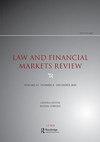The HEM and Hayne’s normative principles – credit data and the individual
IF 0.9
Q2 Social Sciences
引用次数: 1
Abstract
How has a method for calculating living expenses become a byword for distrust and confusion? The HEM encapsulates the mystery of calculation based on aggregated data and the dissolution of the individual into categories. It is at the centre of protracted litigation and legal interpretation of a relatively straightforward legislative provision designed to guide lenders and protect borrowers. It has featured in the Royal Commission into Misconduct in the Banking, Superannuation and Financial Services Industry. The HEM or Household Expenditure Measure is a method to calculate indicative living expenses. It is described as “A measure of what families spend on different types of household items, calculated quarterly by the Melbourne Institute of Applied Economic and Social Research.” The HEMwas constructed at the request of the Risk Managers Roundtable, a group of lenders and others who met to discuss legislative and regulatory matters. The Melbourne Institute is the same body which devised the Henderson Poverty Line to measure poverty in Australia. The Commission of Inquiry into Poverty in Australia, first established in 1972, has been updated annually since that time. In about 2010 the Household Expenditure Measure was based initially on Australian Bureau of Statistics (ABS) information from the ABS Household Expenditure Survey 2009–2010 and is modified quarterly by the Consumer Price Index. This is then adjusted for the HEM by the intended geographic location of the loan applicant, marital status and number of dependents, but not income. In 2012, the Commonwealth Bank of Australia adopted the HEM as a method to calculate living expenses for the purpose of responsible lending obligations. Other lenders followed. It is used for home and car loans. The HEM is based on data to produce an indicative calculation of living expenses. It is not individual to any particular person. It is about categories of persons. The issue is, if a lender relies on the HEM as part of the calculation of whether a potential individual borrower has the capacity to repay a loan without substantial hardship, has that lender met his obligations under responsible lending laws? The regulator, the Australian Securities and Investments Commission (ASIC), says no. One bank, Westpac, admitted breaching the responsible lending laws and was prepared to submit to a penalty until the Federal Court rejected the application by both the regulator and the bank for the resolution. The problem as identified by the Court, was the parties did not agree why there was a contravention, nor how many loans were impacted and judged “not unsuitable” when they should have been assessed as unsuitable. 10 The next hearing is scheduled for six days following 6 May 2019. Into this mix enters the Hayne Royal Commission into Misconduct in the Banking, Superannuation and Financial Services Industry. The Royal Commission canvassed various sectors of the financial services industry including financial advisers, insurance, and superannuation. The findings of the Royal Commission, unfolding each day as front page news and culminating in the Reports, outline the extent of misconduct. The Commission opened with hearings in 2018 on consumer credit, small business credit and later farm credit. Credit is at the heart of any financial system and has been of particular concern in Australia. In this country there are high levels of household debt, historically high levels of mortgage borrowing for home ownership, and recent coordinated steps by the conduct regulator, ASIC, and the prudential regulator, the Australian Prudential Regulation Authority (APRA) to wind back lending. There are two associated credit problems: some believe indebtedness is the result of the lender providing too much credit when they should not have; some believe they have been denied credit, and therefore business or housing opportunities, because the lender did not assess their applications correctly. Both overindebtedness and lack of access to credit bring into play questions of the normative values said to undergird Australia’s financial services system.HEM和Hayne的规范性原则——信用数据和个人
一种计算生活费用的方法怎么会成为不信任和困惑的代名词?HEM封装了基于聚合数据和将个体分解为类别的计算的奥秘。它是旷日持久的诉讼和对一项相对简单的立法条款的法律解释的核心,该条款旨在指导放贷机构和保护借款人。它在皇家委员会调查银行、退休金和金融服务业的不当行为中占有重要地位。家庭开支衡量是一种计算指示性生活开支的方法。它被描述为“衡量家庭在不同类型的家庭用品上的支出,由墨尔本应用经济和社会研究所每季度计算一次。”风险管理机制是应风险管理圆桌会议(Risk Managers Roundtable)的要求制定的。风险管理圆桌会议是一个由贷款机构和其他机构开会讨论立法和监管事宜的组织。墨尔本研究所也是设计亨德森贫困线来衡量澳大利亚贫困的同一机构。澳大利亚贫穷问题调查委员会最初于1972年成立,自那时以来每年都进行更新。大约在2010年,家庭支出衡量最初基于澳大利亚统计局(ABS) 2009-2010年家庭支出调查的信息,并根据消费者价格指数每季度进行修改。然后根据贷款申请人的预期地理位置、婚姻状况和受抚养人数(但不包括收入)对HEM进行调整。2012年,为了履行负责任的贷款义务,澳大利亚联邦银行采用HEM作为计算生活费用的方法。其他贷款机构也纷纷效仿。它用于住房和汽车贷款。最低生活成本是根据数据得出的生活费用的指示性计算。它不是针对任何特定的人。它是关于人的类别。问题是,如果贷款人依赖HEM作为计算潜在个人借款人是否有能力在没有重大困难的情况下偿还贷款的一部分,那么贷款人是否履行了负责任的贷款法律规定的义务?监管机构澳大利亚证券和投资委员会(ASIC)对此表示否定。西太平洋银行(Westpac)承认违反了负责任的贷款法律,并准备接受罚款,直到联邦法院驳回监管机构和该银行提出的解决方案申请。法院查明的问题是,当事各方不同意为什么会有违反规定的情况,也不同意有多少贷款受到影响并被判定为“不适当”,而这些贷款本应被评估为不适当。10 .下一次听证会定于2019年5月6日之后6天举行。海恩皇家委员会调查银行、退休金和金融服务业的不当行为。皇家委员会调查了金融服务行业的各个部门,包括金融顾问、保险和退休金。皇家委员会的调查结果每天都作为头版新闻展开,并在报告中达到高潮,概述了不当行为的程度。该委员会于2018年就消费者信贷、小企业信贷和后来的农业信贷举行了听证会。信贷是任何金融体系的核心,在澳大利亚尤其受到关注。在这个国家,家庭债务水平很高,房屋所有权的抵押贷款水平也处于历史高位,最近,行为监管机构ASIC和审慎监管机构澳大利亚审慎监管局(APRA)采取了协调一致的措施,以减少贷款。有两个相关的信贷问题:一些人认为,负债是贷款人在不应提供过多信贷的情况下提供过多信贷的结果;一些人认为,由于贷款人没有正确评估他们的申请,他们被拒绝了信贷,从而失去了商业或住房机会。过度负债和缺乏获得信贷的渠道,都引发了据称支撑澳大利亚金融服务体系的规范性价值观的问题。
本文章由计算机程序翻译,如有差异,请以英文原文为准。
求助全文
约1分钟内获得全文
求助全文
来源期刊
CiteScore
1.40
自引率
0.00%
发文量
0
期刊介绍:
The Law and Financial Markets Review is a new, independent, English language journal devoted to providing high quality information, comment and analysis for lawyers specialising in banking and financial market issues and to others with interests in legal and regulatory developments affecting the financial markets. Published four times a year LFMR contains articles written by leading experts providing a forum for practical guidance on, as well as reflective and topical analysis of, all major jurisdictions, with a particular focus on the interaction between the law and market practice and behaviour.

 求助内容:
求助内容: 应助结果提醒方式:
应助结果提醒方式:


